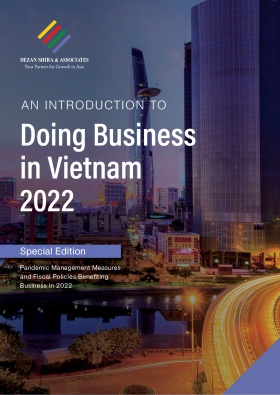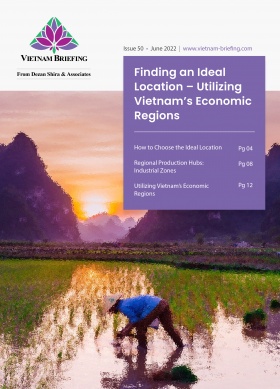Vietnam’s Circular Economy: Decision 687 Development Plan Ratified
This article is part of our partnership with the Green Economy Forum & Exhibition 2022, organized by EuroCham Vietnam, supported by Dezan & Associates Vietnam.
Vietnam is shifting from a linear economy toward a circular economy, targeting sustainable economic development for a more competitive economy. To realize that goal, the government recently issued Decision 687 on circular economy development which was followed earlier by the revised Law on Environmental Protection (LEP). Vietnam Briefing highlights key updates while looking at what these changes would mean for businesses and investors.
Vietnam’s economic activities have been mainly based on a linear economy which means taking a traditional approach to the “take-make-dispose” model. In this model, the use of collected raw materials is maximized during the production process, eventually resulting in the disposal of unusable materials.
This tends to produce a significant amount of unwanted, and sometimes dangerous landfill waste while contributing to the scarcity of raw materials given their irrational usage.
Currently, about 85 percent of the waste generated in Vietnam is buried without treatment in landfill sites, posing tremendous detrimental effects to the environment.
However, Vietnam has been gradually transforming into a circular economy. The circular economy is based on a three-pillar system involving the “make-use-recycle” model, which promotes waste reduction and lowers resource extraction through recycling, reducing, and reusing.
The concept of a circular economy treats used plastics as valuable material resources to be recycled rather than as waste to be discarded. This is highly favorable to promote sustainable development as it introduces an opportunity for Vietnam to scale up recycling and other plastic circularity efforts.
Plastic and waste management situation in Vietnam
As an emerging industrial hub with accelerating economic growth, Vietnam has severe environmental issues, particularly in waste management and plastic pollution. The total volume of waste each year in the country is approximately about 25.5 million tons, of which 75 percent goes into landfills.
According to the World Bank, Vietnam is among the top four generators of plastic waste, at 280,000 tons per year. The pandemic has exacerbated this situation following the increased usage and disposal of facemasks, sanitizer bottles, and e-commerce packaging.
With growing urbanization and a rising middle class, the consumption and demand for plastics have also grown rapidly in consumer packaging, construction, household goods, and automotive industries.
In 2019, the plastic industry contributed about US$17.5 billion to Vietnam’s economy, equivalent to 6.7 percent of the country’s GDP. On average, a Vietnamese now consumes 41.3 kilograms of plastics a year, equivalent to 7,600 plastic grocery bags.
To tackle the situation and towards a sustainable economy, the government has been deploying long-term action plans and setting ambitious recycling targets.
National action plans and strategies
Conscious of growing marine pollution, Vietnam has launched a national action plan for the management of marine plastic litter, aiming to reduce 75 percent of Vietnam’s marine plastic debris by 2030. By then, the country strives to eliminate the use of single-use plastics and non-biodegradable plastic bags from all coastal tourism areas. Meanwhile, all protected marine areas should be free of plastic litter.
The government has also demonstrated a strong dedication to tackle sustainable development and climate change at the Conference of the Parties (COP26) with its commitment to achieving net-zero carbon emissions by 2050.
More recently, Vietnam’s Deputy Prime Minister Le Minh Khai signed Decision 687 approving the national development plan on a circular economy in June.
Accordingly, the plan aims to decrease greenhouse gas emissions per GDP by at least 15 percent compared to 2014. In addition, the plan sets goals to reuse, recycle and treat 85 percent of plastic waste and reduce 50 percent of plastic waste in the sea and ocean.
By 2030, circular economy models will help raise the rate of urban solid waste collection and treatment to 50 percent, recycling 100 percent of organic waste in the urban areas and 70 percent of organic waste in the rural areas.
By 2025, circular economy projects are expected to contribute to recovering renewable resources, reducing energy consumption, and increasing the rate of renewable energy, rate of forest coverage, and waste recycling.
Particularly, the plan highlights the importance of increasing the awareness and investment of domestic and foreign enterprises and investors in the circular economy as an approach to successfully adopting a circular economy model.
The plan itself has also been discussed in the recent kick-off conference organized by the Ministry of Natural Resources and Environment, where government leaders, development partners, ambassadors, and experts announce their strengthened cooperation while sharing successful models, concepts, and approaches to a circular economy.
Building on the launch of the National Plastic Action Partnership, the revised LEP, and other plastic pollution reduction actions, this plan continues to be one of the efforts made by the country to incorporate a circular economy across its industries.
Provisions to the Law on Environmental Protection
In January 2022, the revised Law on Environmental Protection (LEP) 2020 came into effect. In general, the law highlights the responsibilities of ministries and localities to integrate circular economy in planning strategies, development plans, waste management, and waste recycling.
The 2020 LEP introduces the concept of circular economy through fostering extended producer responsibility (EPR) policy, highlighting the responsibility of producers and importers to recycle products and packaging. Following this, the government issued Article 54 and Article 55 which details requirements on collection, disposal, and recycling of waste products, plastic waste, and others.
EPR is an environmental policy approach in which a producer’s responsibility for a product is extended to the waste management stage. It was first introduced in the 2005 Law on Environmental Protection, however, to which no mandatory recycling quota for companies was implemented.
This resulted in their reluctance to facilitate EPR given the lack of specifications from the authorities. Therefore, the provisions of EPR in the revised LEP create a legal framework for EPR to be enforced.
Specifically, the law requires that domestic solid wastes must be sorted into reusable or recyclable solid wastes, food wastes, and other solid domestic wastes. Additionally, Article 54 provides that producers and importers of products and/or packages with recycling value are responsible for collecting them for post-use recycling at the obligatory recycling rates.
This applies to both recyclable products and packaging, and waste treatment. There are two options to which manufacturers can comply with the law:
- organize the recycling themselves according to the given rates and specifications; or
- contribute financially to the Vietnam Environment Protection Fund (VEPF) to support the recycling of their waste.
For example, laptops are products of recycling value. As such, they must be collected for recycling at the recycling rate of 20 percent and according to stated (X) specifications. For example, if Producer A sells 3 million kgs worth of laptops on the Vietnamese market in one year under brand A, producer A must collect and recycle 600,000 kg of after-use (abandoned) laptops.
Article 55 states that “Organizations and individuals producing and/or importing packages, containing toxic substances, which are hardly recyclable or impede the collection and treatment, shall pay financial contributions to support daily-life solid waste treatment activities.”
For example, as per the regulations, cigarette producers and importers are required to pay VND 100 (US$0.0044) to the fund for every 20 cigarettes produced. This is because cigarette tubes are difficult to be collected and treated, requiring producers and importers to contribute to the VEPF as stated earlier.
What does it mean for businesses?
Opportunities
Encouraging plastic recycling in businesses is expected to mobilize increased private sector investment to help address plastic pollution while supporting key industries such as tourism, shipping, and fisheries.
The circular economy also presents four benefits for businesses’ sustainable development which are resource efficiency, environment protection, economic development, and social benefits.
Further action from the government to develop the circular economy can also mean an opportunity for businesses. According to a new study by the World Bank (WB), about 75 percent of the material value of recyclable plastics in Vietnam is lost – the equivalent of US$2.2 to 2.9 billion a year – because used plastics are not sorted, collected, or recovered. This is however likely to change with the government’s new Decree 45/2022/ND/CP which mandates separate of trash. The Decree is expected to take effect on August 25.
Plus, recyclers in Vietnam are still small and scattered with a minimal recycling rate compared to the inputs of the economy. Therefore, with increased support from the government with new national plans and strategies, investors can capture the additional material value and generate revenue through the circular economy. Still, market and structural changes as well as first-time investments are prerequisites for the sector.
Challenges
To comply with the law, Vietnam’s manufacturers and producers will now have to register recycling plans and report recycling results annually to the Ministry of Natural Resources and Environment. Local and foreign-invested companies are also advised to prepare recycling plans and budgets for EPR accordingly to address new requirements imposed by the new law.
However, transforming into a circular economy requires a rigorous regulatory framework that allows all economic sectors to apply the model in their production from manufacturing to consumption and waste management.
With increasing government policies and raising awareness of businesses and the community, Vietnam is set to become a competitive leader in pursuing sustainable economic development
About Us
Vietnam Briefing is produced by Dezan Shira & Associates. The firm assists foreign investors throughout Asia from offices across the world, including in Hanoi, Ho Chi Minh City, and Da Nang. Readers may write to vietnam@dezshira.com for more support on doing business in Vietnam.
We also maintain offices or have alliance partners assisting foreign investors in Indonesia, India, Singapore, The Philippines, Malaysia, Thailand, Italy, Germany, and the United States, in addition to practices in Bangladesh and Russia.
- Previous Article Vietnam’s Food & Beverage Industry: Market Trends, Demographics, Consumer Preferences
- Next Article Perché la vostra strategia di ingresso nel mercato è importante in Vietnam?








